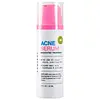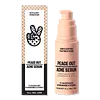What's inside
What's inside
 Key Ingredients
Key Ingredients

 Benefits
Benefits

 Concerns
Concerns

 Ingredients Side-by-side
Ingredients Side-by-side

Salicylic Acid 1.5%
MaskingWater
Skin ConditioningPropanediol
SolventGlycerin
HumectantCaprylic/Capric Triglyceride
MaskingDimethyl Isosorbide
SolventLactobacillus Ferment
Skin ConditioningCoconut Alkanes
EmollientCoco-Caprylate
EmollientNiacinamide
SmoothingCetearyl Alcohol
EmollientBehenyl Alcohol
EmollientCandelilla/Jojoba/Rice Bran Polyglyceryl-3 Esters
EmulsifyingTranexamic Acid
AstringentHexyl Laurate
EmollientGlycine Soja Oil
EmollientC15-19 Alkane
SolventPotassium Azeloyl Diglycinate
Skin ConditioningHydrogenated Polydecene
EmollientGlyceryl Stearate
EmollientCeramide NP
Skin ConditioningCeramide AP
Skin ConditioningBakuchiol
AntimicrobialFucus Spiralis Extract
EmollientTetraselmis Chui Extract
EmollientRhodomyrtus Tomentosa Fruit Extract
HumectantTasmannia Lanceolata Fruit/Leaf Extract
AntioxidantAcetyl Glucosamine
Skin ConditioningHydrolyzed Sodium Hyaluronate
Skin ConditioningZinc Sulfate
AntimicrobialMelia Azadirachta Leaf Extract
Skin ConditioningRosmarinus Officinalis Leaf Extract
AntimicrobialThymus Vulgaris Extract
PerfumingOriganum Vulgare Leaf Extract
Skin ConditioningCentella Asiatica Leaf Extract
Skin ConditioningSilybum Marianum Seed Extract
Skin ConditioningVitex Agnus-Castus Extract
AstringentHelianthus Annuus Extract
EmollientOryza Sativa Bran Extract
Skin ConditioningOryza Sativa Extract
AbsorbentOryza Sativa Germ Extract
EmollientAllantoin
Skin ConditioningPanthenol
Skin Conditioning1,2-Hexanediol
Skin ConditioningSodium Stearoyl Lactylate
EmulsifyingCitric Acid
BufferingXanthan Gum
EmulsifyingPolyglyceryl-3 Diisostearate
EmulsifyingPolyacrylate Crosspolymer-6
Emulsion StabilisingCoco-Caprylate/Caprate
EmollientCaprylhydroxamic Acid
Sodium Phytate
Tocopherol
AntioxidantSodium Benzoate
MaskingPotassium Sorbate
PreservativeBiosaccharide Gum-1
HumectantPhenoxyethanol
PreservativeSodium Levulinate
Skin ConditioningGlyceryl Caprylate
EmollientSodium Anisate
AntimicrobialSalicylic Acid 1.5%, Water, Propanediol, Glycerin, Caprylic/Capric Triglyceride, Dimethyl Isosorbide, Lactobacillus Ferment, Coconut Alkanes, Coco-Caprylate, Niacinamide, Cetearyl Alcohol, Behenyl Alcohol, Candelilla/Jojoba/Rice Bran Polyglyceryl-3 Esters, Tranexamic Acid, Hexyl Laurate, Glycine Soja Oil, C15-19 Alkane, Potassium Azeloyl Diglycinate, Hydrogenated Polydecene, Glyceryl Stearate, Ceramide NP, Ceramide AP, Bakuchiol, Fucus Spiralis Extract, Tetraselmis Chui Extract, Rhodomyrtus Tomentosa Fruit Extract, Tasmannia Lanceolata Fruit/Leaf Extract, Acetyl Glucosamine, Hydrolyzed Sodium Hyaluronate, Zinc Sulfate, Melia Azadirachta Leaf Extract, Rosmarinus Officinalis Leaf Extract, Thymus Vulgaris Extract, Origanum Vulgare Leaf Extract, Centella Asiatica Leaf Extract, Silybum Marianum Seed Extract, Vitex Agnus-Castus Extract, Helianthus Annuus Extract, Oryza Sativa Bran Extract, Oryza Sativa Extract, Oryza Sativa Germ Extract, Allantoin, Panthenol, 1,2-Hexanediol, Sodium Stearoyl Lactylate, Citric Acid, Xanthan Gum, Polyglyceryl-3 Diisostearate, Polyacrylate Crosspolymer-6, Coco-Caprylate/Caprate, Caprylhydroxamic Acid, Sodium Phytate, Tocopherol, Sodium Benzoate, Potassium Sorbate, Biosaccharide Gum-1, Phenoxyethanol, Sodium Levulinate, Glyceryl Caprylate, Sodium Anisate
Salicylic Acid 2%
MaskingWater
Skin ConditioningPropanediol
SolventDimethicone
EmollientNiacinamide
SmoothingIsopentyldiol
HumectantSodium Polyacryloyldimethyl Taurate
Emulsion StabilisingZinc PCA
Humectant3-O-Ethyl Ascorbic Acid
Skin ConditioningAloe Barbadensis Leaf Extract
EmollientCentella Asiatica Extract
CleansingTrifolium Pratense Flower Extract
AstringentSodium Hyaluronate
HumectantSaccharide Isomerate
HumectantGlycerin
HumectantEthylhexylglycerin
Skin ConditioningPotassium Azeloyl Diglycinate
Skin ConditioningCetearyl Olivate
Butylene Glycol
HumectantSorbitan Olivate
EmulsifyingPolysilicone-11
Decyl Glucoside
CleansingCaprylyl Glycol
Emollient1,2-Hexanediol
Skin ConditioningMaltodextrin
AbsorbentEthoxydiglycol
HumectantTotarol
AntioxidantLavandula Hybrida Oil
EmollientCitrus Aurantium Bergamia Fruit Oil
MaskingTocopheryl Acetate
AntioxidantPhenoxyethanol
PreservativeDisodium EDTA
Potassium Hydroxide
BufferingSalicylic Acid 2%, Water, Propanediol, Dimethicone, Niacinamide, Isopentyldiol, Sodium Polyacryloyldimethyl Taurate, Zinc PCA, 3-O-Ethyl Ascorbic Acid, Aloe Barbadensis Leaf Extract, Centella Asiatica Extract, Trifolium Pratense Flower Extract, Sodium Hyaluronate, Saccharide Isomerate, Glycerin, Ethylhexylglycerin, Potassium Azeloyl Diglycinate, Cetearyl Olivate, Butylene Glycol, Sorbitan Olivate, Polysilicone-11, Decyl Glucoside, Caprylyl Glycol, 1,2-Hexanediol, Maltodextrin, Ethoxydiglycol, Totarol, Lavandula Hybrida Oil, Citrus Aurantium Bergamia Fruit Oil, Tocopheryl Acetate, Phenoxyethanol, Disodium EDTA, Potassium Hydroxide
Ingredients Explained
These ingredients are found in both products.
Ingredients higher up in an ingredient list are typically present in a larger amount.
1,2-Hexanediol is a synthetic liquid and another multi-functional powerhouse.
It is a:
- Humectant, drawing moisture into the skin
- Emollient, helping to soften skin
- Solvent, dispersing and stabilizing formulas
- Preservative booster, enhancing the antimicrobial activity of other preservatives
Glycerin is already naturally found in your skin. It helps moisturize and protect your skin.
A study from 2016 found glycerin to be more effective as a humectant than AHAs and hyaluronic acid.
As a humectant, it helps the skin stay hydrated by pulling moisture to your skin. The low molecular weight of glycerin allows it to pull moisture into the deeper layers of your skin.
Hydrated skin improves your skin barrier; Your skin barrier helps protect against irritants and bacteria.
Glycerin has also been found to have antimicrobial and antiviral properties. Due to these properties, glycerin is often used in wound and burn treatments.
In cosmetics, glycerin is usually derived from plants such as soybean or palm. However, it can also be sourced from animals, such as tallow or animal fat.
This ingredient is organic, colorless, odorless, and non-toxic.
Glycerin is the name for this ingredient in American English. British English uses Glycerol/Glycerine.
Learn more about GlycerinNiacinamide is a multitasking form of vitamin B3 that strengthens the skin barrier, reduces pores and dark spots, regulates oil, and improves signs of aging.
And the best part? It's gentle and well-tolerated by most skin types, including sensitive and reactive skin.
You might have heard of "niacin flush", or the reddening of skin that causes itchiness. Niacinamide has not been found to cause this.
In very rare cases, some individuals may not be able to tolerate niacinamide at all or experience an allergic reaction to it.
If you are experiencing flaking, irritation, and dryness with this ingredient, be sure to double check all your products as this ingredient can be found in all categories of skincare.
When incorporating niacinamide into your routine, look out for concentration amounts. Typically, 5% niacinamide provides benefits such as fading dark spots. However, if you have sensitive skin, it is better to begin with a smaller concentration.
When you apply niacinamide to your skin, your body converts it into nicotinamide adenine dinucleotide (NAD). NAD is an essential coenzyme that is already found in your cells as "fuel" and powers countless biological processes.
In your skin, NAD helps repair cell damage, produce new healthy cells, support collagen production, strengthen the skin barrier, and fight environmental stressors (like UV and pollution).
Our natural NAD levels start to decline with age, leading to slower skin repair, visible aging, and a weaker skin barrier. By providing your skin niacinamide, you're recharging your skin's NAD levels. This leads to stronger, healthier, and younger looking skin.
Another name for vitamin B3 is nicotinamide. This vitamin is water-soluble and our bodies don't store it. We obtain Vitamin B3 from either food or skincare. Meat, fish, wheat, yeast, and leafy greens contain vitamin B3.
The type of niacinamide used in skincare is synthetically created.
Learn more about NiacinamidePhenoxyethanol is a preservative that has germicide, antimicrobial, and aromatic properties. Studies show that phenoxyethanol can prevent microbial growth. By itself, it has a scent that is similar to that of a rose.
It's often used in formulations along with Caprylyl Glycol to preserve the shelf life of products.
Potassium Azeloyl Diglycinate (PAD) comes from the condensation of azelaic acid mixed with glycine.
This ingredient has similar properties to azelaic acid; it can help reduce sebum production and soothe skin. PAD also inhibits tyrosinase activity to help brighten skin. Tyrosinase is an enzyme that controls melanin production.
A study from 2023 found 5% PAD combined with nicotinamide (a form of niacin) effectively reduced melanin production after 6 weeks.
Several studies from the 2010's also show PAD to be effective in alleviating symptoms of Rosacea.
Though this ingredient is considered a gentle active, higher amounts may result in irritation.
Unlike azelaic acid, this ingredient is water-soluble. This property makes it easier to formulate into skincare products.
Learn more about Potassium Azeloyl DiglycinatePropanediol is an all-star ingredient. It softens, hydrates, and smooths the skin.
It’s often used to:
Propanediol is not likely to cause sensitivity and considered safe to use. It is derived from corn or petroleum with a clear color and no scent.
Learn more about PropanediolSalicylic Acid (also known as beta hydroxy acid or BHA) is a well-known ingredient for treating skin that struggles with acne and clogged pores. It exfoliates both the skin's surface and deep within the pores to help clear out buildup, control oil, and reduce inflammation.
Unlike AHAs (alpha hydroxy acids), salicylic acid is oil-soluble. This allows it to penetrate into pores which makes it especially effective for treating blackheads and preventing future breakouts.
Salicylic acid is also known for its soothing properties. It has a similar structure to aspirin and can calm inflamed or irritated skin, making it a good option for acne-prone skin that is also sensitive.
Concentrations of 0.5-2% are recognized by the U.S. FDA as an over-the-counter topical acne product.
It can cause irritation and/or dryness if one's skin already has a compromised moisture barrier, so it's best to focus on repairing that before introducing this ingredient into your routine.
While salicylic acid does not increase sun sensitivity, it’s still important to wear sunscreen daily to protect your skin.
If you are looking for the ingredient called BHA or Butylated Hydroxyanisole, click here.
Learn more about Salicylic AcidWater. It's the most common cosmetic ingredient of all. You'll usually see it at the top of ingredient lists, meaning that it makes up the largest part of the product.
So why is it so popular? Water most often acts as a solvent - this means that it helps dissolve other ingredients into the formulation.
You'll also recognize water as that liquid we all need to stay alive. If you see this, drink a glass of water. Stay hydrated!
Learn more about Water